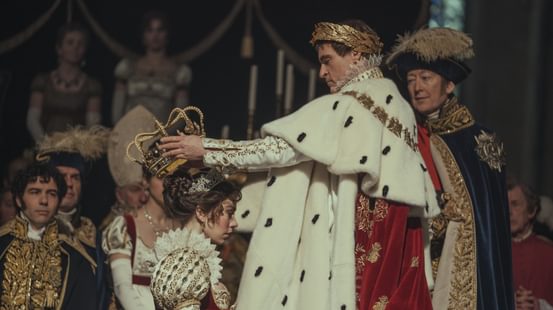News Story
Open an image gallery
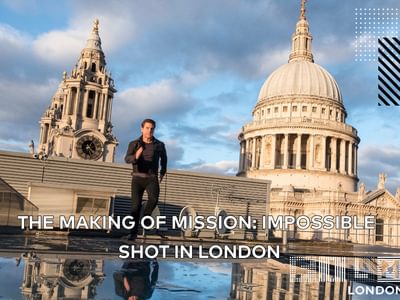
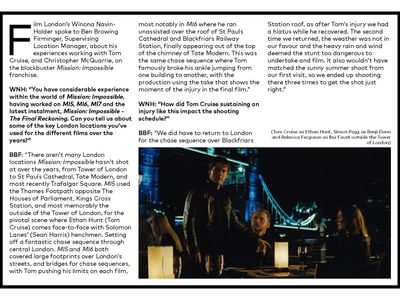
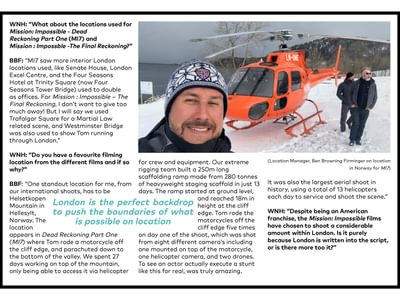
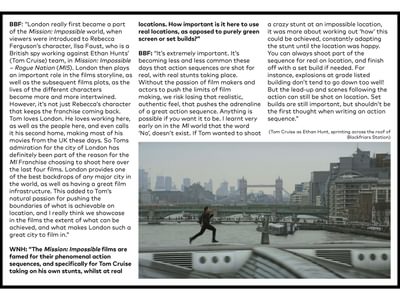
Film London’s Winona Navin-Holder spoke to Ben Browning Firminger, Supervising Location Manager, about his experiences working with Tom Cruise, and Christopher McQuarrie, on the blockbuster Mission:Impossible franchise.
WNH: “You have considerable experience within the world of Mission: Impossible, having worked on MI5, MI6, MI7 and the latest instalment, Mission: Impossible - The Final Reckoning. Can you tell us about some of the key London locations you’ve used for the different films over the years?”
BBF: “There aren’t many London locations Mission:Impossible hasn’t shot at over the years, from Tower of London to St Pauls Cathedral, Tate Modern, and most recently Trafalgar Square. MI5 used the Thames Footpath opposite The Houses of Parliament, Kings Cross Stations, and most memorably the outside of the Tower of London, for the pivotal scene where Ethan Hunt (Tom Cruise) comes face-to-face with Solomon Lanes’ (Sean Harris) henchmen. Setting off a fantastic chase sequence through central London. MI5 and MI6 both covered large footprints over London’s streets, and bridges for chase sequences, with Tom pushing his limits on each film, most notably in MI6 where he ran unassisted over the roof of St Pauls Cathedral and Blackfriars Railway Station, finally appearing out of the top of the chimney of Tate Modern. This was the same chase sequence where Tom famously broke his ankle jumping from one building to another, with the production using the take that shows the moment of the injury in the final film.
WNH: “How did Tom Cruise sustaining an injury like this impact the shooting schedule?”
BBF: “We did have to return to London for the chase sequence over Blackfriars Station roof, as after Tom’s injury we had a hiatus while he recovered. The second time we returned, the weather was not in our favour and the heavy rain and wind deemed the stunt too dangerous to undertake and film. It also wouldn’t have matched the sunny summer shoot from our first visit, so we ended up shooting there three times to get the shot just right.”
WNH: “What about the locations used for Mission: Impossible – Dead Reckoning Part One (MI7) and Mission : Impossible – The Final Reckoning?”
BBF: “MI7 saw more interior London locations used, like Senate House, London Excel Centre, and the Four Seasons Hotel at Trinity Square (now Four Seasons Tower Bridge) used to double as offices. For Mission : Impossible – The Final Reckoning, I don’t want to give too much away! But I will say we used Trafalgar Square for a Martial Law related scene, and Westminster Bridge was also used to show Tom running through London.”
WNH:“Do you have a favourite filming location from the different films and if so why?”
BBF: “One standout location for me, from our international shoots, has to Helsetkopen Mountain in Hellesylt, Norway. The location appears in Dead Reckoning Part One (MI7) where Tom rode a motorcycle off the cliff edge, and parachuted down to the bottom of the valley. We spent 27 days working on top of the mountain, only being able to access it via helicopter for crew and equipment. Our extreme rigging team built a 250m long scaffolding ramp made from 280 tonnes of heavyweight staging scaffold in just 13 days. The ramp started at ground level, and reached 18m in height at the cliff edge. Tom rode the motorcycles off the cliff edge five times on day one of the shoot, which was shot from eight different camera’s including one mounted on top of the motorcycle, one helicopter camera, and two drones. To see an actor actually execute a stunt like this for real, was truly amazing. It was also the largest aerial shoot in history, using a total of 13 helicopters each day to service and shoot the scene.”
WNH: “Despite being an American franchise, the Mission: Impossible films have chosen to shoot a considerable amount within London. Is it purely because London is written into the script, or is there more too it?”
BBF: “London really first became a part of the Mission: Impossible world, when viewers were introduced to Rebecca Ferguson’s character, Ilsa Faust, who is a British spy working against Ethan Hunts’ (Tom Cruise) team, in Mission: Impossible – Rogue Nation (MI5). London then plays an important role in the films storyline, as well as the subsequent films plots, as the lives of the different characters become more and more intertwined. However, it’s not just Rebecca’s character that keeps the franchise coming back. Tom loves London. He loves working here, as well as the people here, and even calls it his second home, making most of his movies from the UK these days. So Toms admiration for the city of London has definitely been part of the reason for the MI Franchise choosing to shoot here over the last four films. London provides one of the best backdrops of any major city in the world, as well as having a great film infrastructure. This added to Tom’s natural passion for pushing the boundaries of what is achievable on location, and I really think we showcase in the films the extent of what can be achieved, and what makes London such a great city to film in.”
WNH: “The Mission:Impossible films are famed for their phenomenal action sequences, and specifically for Tom Cruise taking on his own stunts, whilst at real locations. How important is it here to use real locations, as opposed to purely green screen or set builds?”
BBF: “It’s extremely important. It’s becoming less and less common these days that action sequences are shot for real, with real stunts taking place. Without the passion of film makers and actors to push the limits of film making, we risk losing that realistic, authentic feel, that pushes the adrenaline of a great action sequence. Anything is possible if you want it to be. I learnt very early on in the MI world that the word ‘No’, doesn’t exist. If Tom wanted to shoot a crazy stunt at an impossible location, it was more about working out ‘how’ this could be achieved, constantly adapting the stunt until the location was happy. You can always shoot part of the sequence for real on location, and finish off with a set build if needed. For instance, explosions at grade listed building don’t tend to go down too well! But the lead-up and scenes following the action can still be shot on location. Set builds are still important, but shouldn’t be the first thought when writing an action sequence.”
WNH: “Are there any logistical challenges that come with filming these kinds of sequences within central London?”
BBF: “Without a doubt! Large action films take a long time to plan. We often need to close multiple streets for the action itself, e.g. to film a car chase, or to install machinery like large cranes for lighting purposes or stunt work. Resident and business consultations must be undertaken so everyone is aware of what is going on, which include multiple letter drops and face-to-face meetings. This normally starts a minimum of 3 months before the filming date. On top of this we might need to have streets cleared of vehicles, and street furniture removed so that we can install our own vehicles and props to fit the scene. Alternative parking sometimes needs to be found for anyone being displaces, and on a rare occasion alternative accommodation might need sourcing for residents. Then of course there are all of the logistics of the shoot day itself. Finding a base for all of our equipment and servicing vehicles which can be more than 50 trucks and trailers, as well as a crowd base for any supporting artists, that is walkable to the location. The Location department will also then be responsible for closing roads with traffic management teams, employing marshals to manage the public, booking any police and security that are needed, and of course making sure everyone knows where the toilets are! All in all the Location department can be responsible for over 100 personal on a large shoot day in London, to ensure everything runs smoothly and safely, but that’s all part of the job.”
WNH: “Could you tell us a little bit about the location research and recceing process for Mission:Impossible?”
BBF: “The pre-production period on any MI film is great fun. You are often given a blank slate by director Christopher McQuarrie, and told to go and find the coolest and most unique looking locations from around the world, to give him inspiration for what could be shot there. There are months and months of researching and scouting all over the world before any decisions are made, which is the dream job for any Location Scout. It’s always good to make sure you’re not showing Christopher or Tom the same locations twice though, so looking through all the old scouting folders (there are a few) and re-watching the previous films are important so as not to get caught out. McQ as he’s known, comes on all of the director’s scouts and the technical recce’s once the locations have been chosen. He really gets involved with each location and makes sure the crew know what he wants to achieve. Tom will also come on some of the early location scouts, especially if he will be performing a big stunt sequence there, so that he can familiarise himself with the location prior to the shoot. You can be on the production for up to a year before filming starts, and then another year for the filming itself. It’s certainly not a short job.”
WNH: “How has the scope or ambition of the films changed as the franchise has progressed?”
BBF: “I think like any franchise the production is always looking for ways to keep the viewers interested and engaged. Each new MI film is bigger and bolder than the last. Tom is constantly coming up with crazier and crazier stunts, so you then have to find new locations that can live up to them. The bigger the stunts, the more prep time required to practice and train, and the more crew required to facilitate them. I remember going to New Zealand at the start of MI7 for six weeks, to manage Tom’s stunt training camp. There were 25 of us in total, including local crew, and no cameras. It was pure stunt training. Then when we came to the shoot day for this particular stunt, there were over 250 crew on set! So as the ambitions of the franchise grow, so does the scale and size of the production.”
WNH: “Has there ever been anything within the scripts or production plans that you thought would be impossible to achieve that you were ultimately able to pull off?”
BBF: “Yes, in every film. As I mentioned earlier, Tom is always trying to push the boundaries of what is possible within filmmaking, so you have to be prepared for the unimaginable. When we got the script for MI6, the end act involved a scene where Tom is fighting on the roof of a steam train, before it inevitably crashes off the end of a bridge into a ravine. On a normal film you’d probably just shoot the interiors of a real train on a railway, and then use CGI for the train crashing at the end. Instead, our SFX team built a fully functioning steam train complete with carriages, and shipped it to a working railway in Norway to run it up and down the line for a week, in order to shoot the fight sequence for real. If you’ve ever tried working with trains before you’ll know they are one of the hardest to film on or with due to safety and working regulations. Never mind building a train to correct specifications, to run on a public railway, whilst closing it to the public for a week, and having to transport said train from the UK to Norway. There were many months of face-to-face meetings with Norwegian Government officials and the Railway Operator, but we managed to get it approved and the final edit in the film shows just how awesome this scene and location really is.”
WNH: “What has been your overall experience working on the Mission: Impossible films? Have there been any particular challenges you and your team have come up against?”
BBF: “It’s been the most rewarding experience of my career working on the MI franchise. Over the years I’ve been able to work closely with some of the best Heads of Departments, Directors and Actors and learnt not just how to do my job to the highest standard, but also how not to do my job which is equally important. Tom and McQ expect the highest calibre of work ethic on and off set, and this brings a good working atmosphere to the job also. The want and determination to be the best you can, all the time.
“Every MI film has been a challenge, but that’s what draws you back in to keep achieving higher goals each time. The hardest period I ever encountered was post-COVID. We were one of the first productions to return to work with the new rules and regulations set-up by the UK Government, Paramount Pictures, and our own production regulations. This made it extremely complication to do our job. Adjusting to these new rules, whilst trying to film complex action sequences on location really pushed the limits of the crew, all whilst being in the public eye. So much extra equipment, crew and time was needed per day that our shoot schedule instantly doubled. I think the total shoot days on MI7 was over 280. It was an immense challenge, but I’m very proud of what we were able to achieve, and how we adapted to the circumstances.”
WNH: “Having put in so much work across the different films, what has been your favourite part of working on the Mission:Impossible franchise?”
BBF: “A combination of being able to travel all around the world, some of the locations I’ve visited we didn’t even shoot at in the end, but I still go the luxury of exploring them. Or those constant ‘pinch me’ moments when you’re flying in a helicopter to a location, being piloted by Tom Cruise himself.”
WNH: “Is there any location that you haven’t yet used for Mission:Impossible that you would like to? What would be your dream location?”
BBF: “Space? There are lots of locations that never quite made the cut over the years on MI for one reason or another, but if I was to work on another MI film, I’d like to see them shoot in Mexico or one of the South American Countries.
“For me, I’ve always wanted to shoot in Russia. My dad shot there many years ago on a Jackie Chan film, and it’s always caught my eye. I’m not sure how possible that might be in the future, so if there’s any chance to get there, I’ll take it.
And London, of course, we’ll always return to London.”
Interview by Winona Navin-Holder
Londoners were in for a surprise on 11th May when Tom Cruise scaled the BFI Imax in tux! The daring stunt was to promote Mission: Impossible – The Final Reckoning, which is released nation-wide on 21ST May. Cruise, famous for doing his own stunts, stood on top of the 65ft high iconic cinema for a drone shot – home to the UK’s largest cinema screen.
Supervising Location Manager, Harriet Lawrence, who made the whole thing happen, said... “When I was first asked by Emma from Helicopter Girls and then Paramount, I thought given the very short turnaround we would get a firm ‘No’. But I like a challenge and thought, let’s give it a go, I might as well ASK the question! Huge thanks to everyone from Transport for London, Film London and Lambeth Council, who got behind this to help make it happen.”
Mission: Impossible - The Final Reckoning is in cinemas nationwide from 21st May.
Watch the trailer here.
